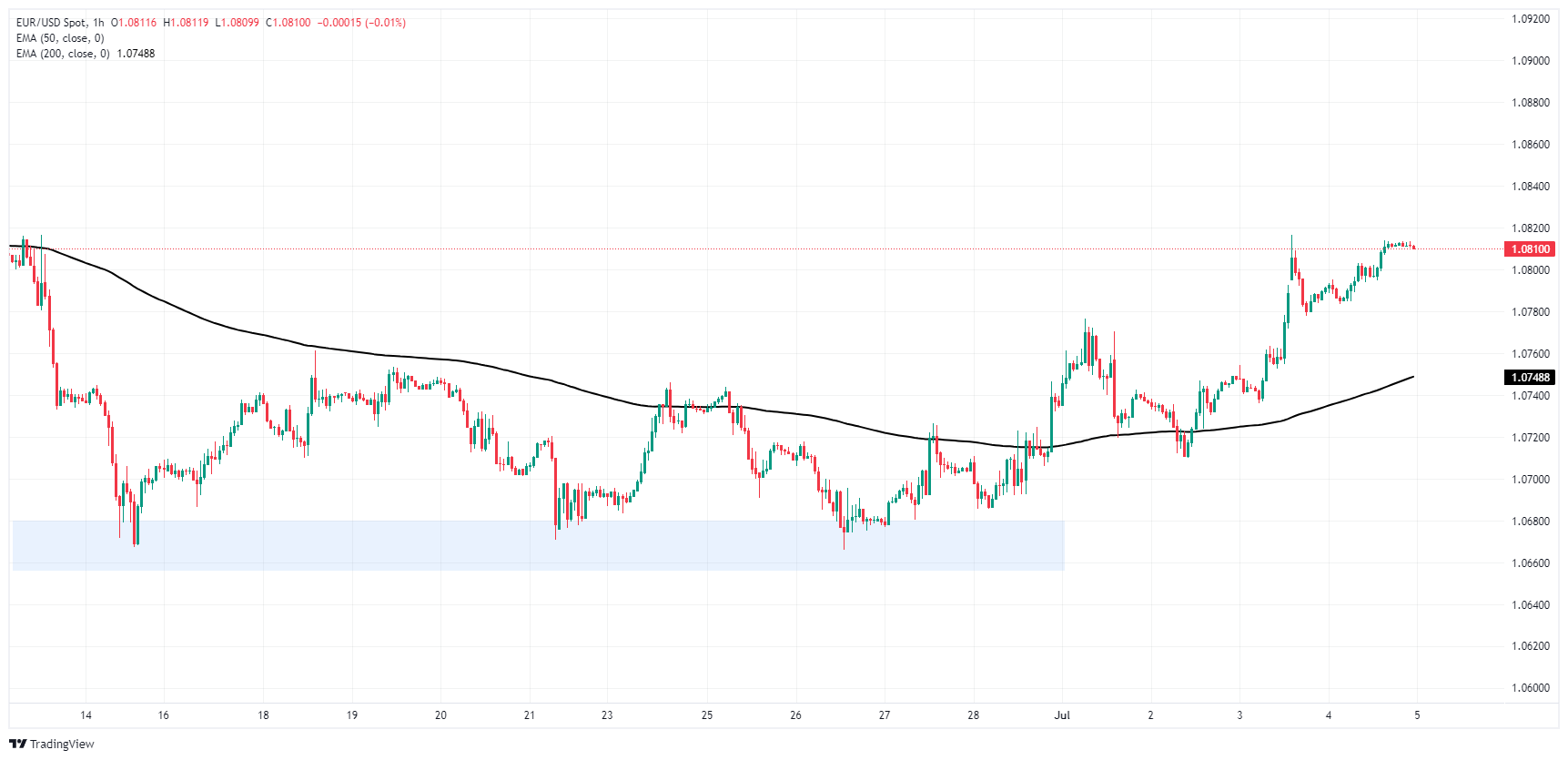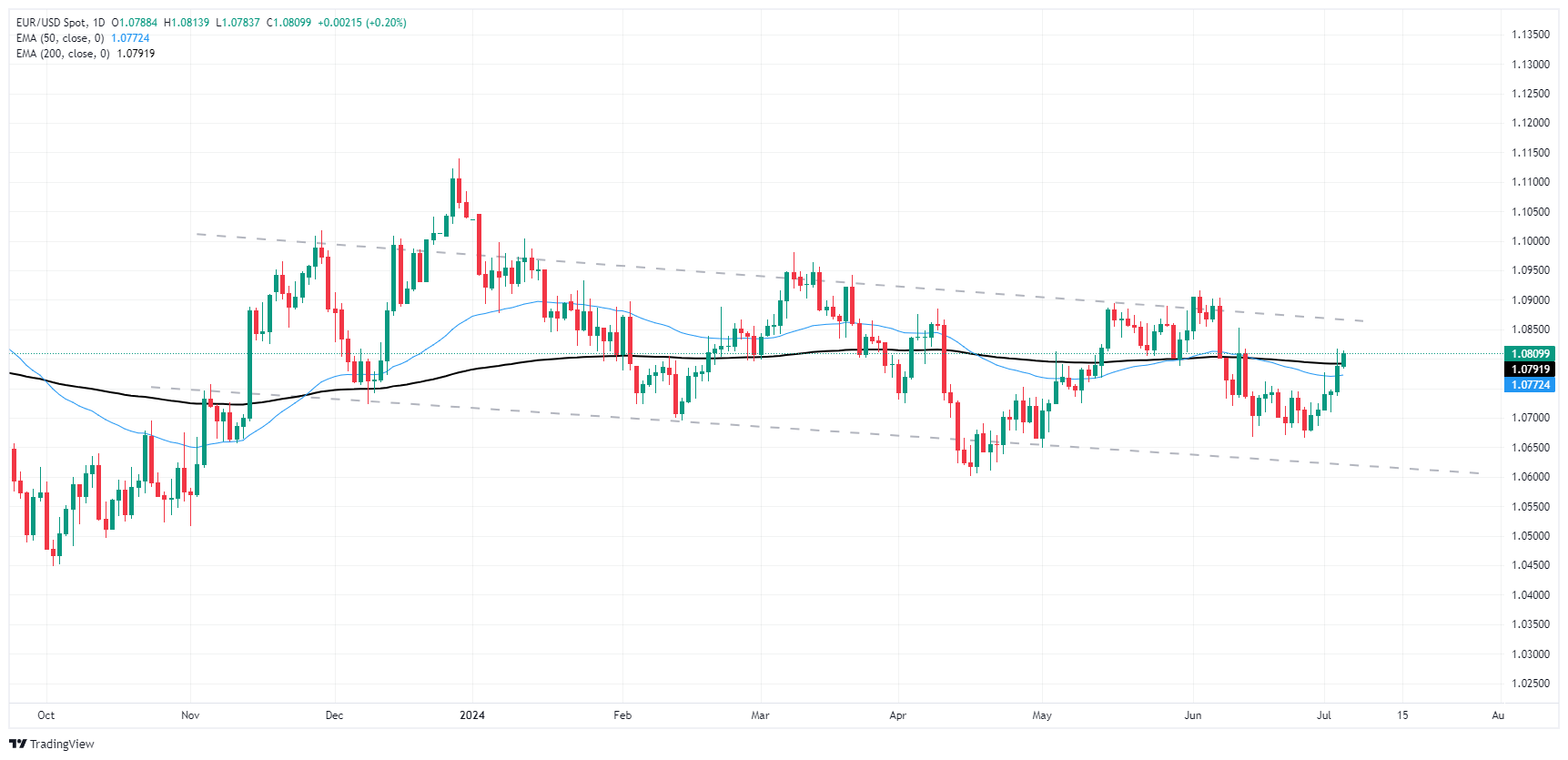EUR/USD holds steady with US NFP, EU Retail Sales in the barrel
- EUR/USD is grasping bids on the high side ahead of a packed Friday.
- Euro bulls are shrugging off a miss in German factory activity.
- EU Retail Sales, US NFP loom large to cap off the trading week.
EUR/USD has chalked in a sixth consecutive trading day in green as Friday’s economic data docket looms large ahead. European Retail Sales and the latest round of US Nonfarm Payrolls (NFP) jobs data could see a significant amount of chart churn. US markets will be returning to the fold after taking Thursday off for the US Independence Day holiday, and market activity is set to tick back up noticeably during Friday’s US trading window.
Forex Today: The US Payrolls takes center stage
German Factory Orders missed the mark on Thursday, declining -1.6% MoM in May versus the previous -0.2%, and entirely missing the forecast 0.5% upswing. Despite softer European figures, a broad-market softening of the US Dollar helped to keep Fiber bolstered into near-term highs just north of 1.0800.
Pan-EU Retail Sales will be releasing early Friday. MoM Retail Sales are expected to rebound to 0.2% in May compared to the previous -0.5% contraction, while annualized Retail Sales are forecast to tick up to 0.1% YoY from the previous 0.0%.
US NFP figures are expected to tick down to 190K in June, down from the previous month’s 272K. Markets will also be on the lookout for steep revisions to previous releases, while June’s US Unemployment rate is expected to hold steady at 4.0% MoM.
US Average Hourly Earnings are expected to cool slightly in June, forecast to ease to 3.9% YoY compared to the previous annualized period’s 4.1%.
Economic Indicator
Nonfarm Payrolls
The Nonfarm Payrolls release presents the number of new jobs created in the US during the previous month in all non-agricultural businesses; it is released by the US Bureau of Labor Statistics (BLS). The monthly changes in payrolls can be extremely volatile. The number is also subject to strong reviews, which can also trigger volatility in the Forex board. Generally speaking, a high reading is seen as bullish for the US Dollar (USD), while a low reading is seen as bearish, although previous months' reviews and the Unemployment Rate are as relevant as the headline figure. The market's reaction, therefore, depends on how the market assesses all the data contained in the BLS report as a whole.
Read more.Next release: Fri Jul 05, 2024 12:30
Frequency: Monthly
Consensus: 190K
Previous: 272K
Source: US Bureau of Labor Statistics
America’s monthly jobs report is considered the most important economic indicator for forex traders. Released on the first Friday following the reported month, the change in the number of positions is closely correlated with the overall performance of the economy and is monitored by policymakers. Full employment is one of the Federal Reserve’s mandates and it considers developments in the labor market when setting its policies, thus impacting currencies. Despite several leading indicators shaping estimates, Nonfarm Payrolls tend to surprise markets and trigger substantial volatility. Actual figures beating the consensus tend to be USD bullish.
EUR/USD technical outlook
Fiber has extended a near-term bullish bounce from a demand zone priced in below 1.0680, and is testing chart territory just north of the 1.0800 handle. Despite a recent bullish tilt, EUR/USD continues to churn in the middle of a rough descending channel on daily candlesticks.
Fiber is poised to run out of bullish gas as bids extend past the 200-day Exponential Moving Average (EMA) at 1.0793. A firm push further into bull country will leave the Fiber poised for a challenge of descending technical resistance and the last major swing high into the 1.0900 handle.
EUR/USD hourly chart
EUR/USD daily chart
Euro FAQs
The Euro is the currency for the 20 European Union countries that belong to the Eurozone. It is the second most heavily traded currency in the world behind the US Dollar. In 2022, it accounted for 31% of all foreign exchange transactions, with an average daily turnover of over $2.2 trillion a day. EUR/USD is the most heavily traded currency pair in the world, accounting for an estimated 30% off all transactions, followed by EUR/JPY (4%), EUR/GBP (3%) and EUR/AUD (2%).
The European Central Bank (ECB) in Frankfurt, Germany, is the reserve bank for the Eurozone. The ECB sets interest rates and manages monetary policy. The ECB’s primary mandate is to maintain price stability, which means either controlling inflation or stimulating growth. Its primary tool is the raising or lowering of interest rates. Relatively high interest rates – or the expectation of higher rates – will usually benefit the Euro and vice versa. The ECB Governing Council makes monetary policy decisions at meetings held eight times a year. Decisions are made by heads of the Eurozone national banks and six permanent members, including the President of the ECB, Christine Lagarde.
Eurozone inflation data, measured by the Harmonized Index of Consumer Prices (HICP), is an important econometric for the Euro. If inflation rises more than expected, especially if above the ECB’s 2% target, it obliges the ECB to raise interest rates to bring it back under control. Relatively high interest rates compared to its counterparts will usually benefit the Euro, as it makes the region more attractive as a place for global investors to park their money.
Data releases gauge the health of the economy and can impact on the Euro. Indicators such as GDP, Manufacturing and Services PMIs, employment, and consumer sentiment surveys can all influence the direction of the single currency. A strong economy is good for the Euro. Not only does it attract more foreign investment but it may encourage the ECB to put up interest rates, which will directly strengthen the Euro. Otherwise, if economic data is weak, the Euro is likely to fall. Economic data for the four largest economies in the euro area (Germany, France, Italy and Spain) are especially significant, as they account for 75% of the Eurozone’s economy.
Another significant data release for the Euro is the Trade Balance. This indicator measures the difference between what a country earns from its exports and what it spends on imports over a given period. If a country produces highly sought after exports then its currency will gain in value purely from the extra demand created from foreign buyers seeking to purchase these goods. Therefore, a positive net Trade Balance strengthens a currency and vice versa for a negative balance.